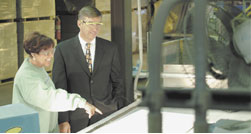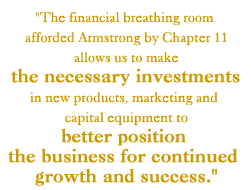

|
2000 was a difficult year for Armstrong. Lower income and increasing asbestos liability created critical
challenges for the Company. By the end of the year, however, Armstrong had taken its first steps to insure survival well into the third millennium - steps toward renewal and revitalization. Renewal of our commitment to serve fairly and in proper balance the interests of all constituencies of the Company. Revitalization of our drive to be the worldwide leader in floors and ceilings.
|
 Wendy Smeltzer shows Mike Lockhart the packaging process for ceiling tiles at the manufacturing facility in Marietta, Pennsylvania
|
||
| Asbestos On December 6, 2000, Armstrong filed for voluntary protection under Chapter 11 of the federal bankruptcy code. Our objective for this action is to achieve a resolution of all Armstrong's liability for
asbestos claims.
Asbestos claims had been expected to decline in 2000. But, as in 1999 when the increase in claims was higher than previously anticipated, claims again rose. By September, claims had risen more than 10 percent, and while claims from major, established asbestos law firms did decline, they were replaced by more claims from new or previously low-volume law firms. The quality of claims from these new sources is unknown. The Strategic Settlement Program (SSP) gained ground during 2000. By the Third Quarter, about 50 percent of the claims in backlog were covered by the SSP. This ameliorated the cost to settle current and future claims. This beneficial effect, however, was more than offset by the inability of the Center for Claims Resolution (CCR) to obtain lower settlements for non-SSP claims to reflect the reduced number of CCR members in 2000. In the Second Quarter, we posted an additional reserve of $236 million to cover the growing asbestos liability. Claims evolution in the Third Quarter was unfavorable, but the data were not sufficient to support an increase to the reserve at that time. In October, Owens Corning, another company affected by asbestos claims, filed for protection under Chapter 11. The immediate effect on Armstrong was to make it impossible to renew a 364-day credit line on terms we found acceptable, creating a liquidity crisis. The second effect was a possible upward bias in the settlement demands of asbestos plaintiffs, given the exit from the tort system of this important defendant in asbestos litigation. After trying a number of approaches to manage our asbestos liability, we faced both increasing claims and the cost to resolve them. These factors, together with the consequences resulting from Owens Corning filing for Chapter 11 protection were the principal factors which led to our decision to file for protection under Chapter 11. Chapter 11 does have disadvantages. Its rules put the Company's equity at risk, and it can be a long process. The average asbestos Chapter 11 resolution has taken six years. Strong differences of opinion about the size of the asbestos liability delay achieving a consensual solution. Determined, pragmatic people should be able to find an earlier solution that is in everyone's interest. Chapter 11 offers Armstrong real advantages. It is a court-supervised mechanism for resolving Armstrong's liability for asbestos claims. The financial breathing room afforded Armstrong by Chapter 11 allows us to make the necessary investments in new products, marketing and capital equipment to better position the business for continued growth and success. Everyone in the Chapter 11 process benefits from a more valuable company, which is the objective of our operating strategy. For Armstrong, Chapter 11 gives us the opportunity to emerge as a stronger company, unencumbered by asbestos.
|
|||
| Operations Overall results were disappointing. Sales were down 1.5 percent. After eliminating unusual items, operating income was down over 25 percent.
Lower volume, price pressure and increased raw material costs reduced operating income by more than $150 million. Cost reductions in manufacturing expenses and selling, general and administrative expenses offset just over $50 million of this. Raw material cost increases were the most significant negative as the high cost of oil drove cost increases in vinyl floor raw materials; natural gas prices more than tripled; and lumber costs increased over 10 percent. Productivity for Armstrong has averaged a 1 percent to 2 percent gain per year from 1996 through 1999. In 2000, it was negative. Our 2001 plan anticipates productivity improvement around 2 percent - better but not where we would like to be. Our markets softened throughout the year, and the Fourth Quarter ended on a weak note. We expect this weakness to continue into 2001. This means lower volume and likely selling price pressure. We do not expect raw material costs to decline from current high levels. This means operating income will likely decline again in 2001. Contributing to the decline are a number of compensation and benefit changes driven by a lower stock price and the Chapter 11 filing. In 2000, we created cash balance accounts in our qualified pension plan for our Employee Stock Ownership Plan (ESOP) participants to replace a benefit that had been destroyed by the asbestos-driven decline in our stock. This will have a significant non-cash effect on earnings. We introduced a two-year cash incentive to replace stock options to enable our people to earn market-level compensation. These changes reduce earnings considerably, but they are essential to keeping a well-motivated workforce.
|
 |
||
| Strategy Armstrong can be the global leader in floors and ceilings. We already are the market share leader in the United States. We are working to extend our leadership through product innovation and marketing creativity, and we took action to strengthen our position in Europe.
In February 2001, Building Products unveiled its i-ceilings™ product line - an exciting addition that helps architects solve the thorny problem of maintaining aesthetics while delivering the communications infrastructure needed in today's offices. Wood Products continues to develop exciting new products in both floors and cabinets, using new structures and new materials. Floor Products has seen wonderful acceptance of ToughGuard™ - our new high-performance vinyl floor. International market opportunities need to be better understood. We announced a restructuring of DLW, our German flooring organization, to make it a more integrated part of Armstrong. We now need to develop a growth strategy for this business, and to search all geographies for opportunities to grow. We are also working to sharpen our focus on customer satisfaction at all levels - consumer, retailer and distributor. This demands improved processes and policies that reduce the number of problems and claims, while speeding resolution of problems and claims that do arise. Customer Service will be the first area to apply our new Trailblazing concept.
|
|||
| Trailblazing Our first strategic objective is winning in the marketplace. Our second objective is to become more productive in everything we do. This entails engaging the energies and intelligence of all our employees. Our Trailblazing initiative, an adaptation of General Electric's Work-Out™ concept, will enable us to bring people together from multiple disciplines to quickly identify, and make, the changes needed to permit the people at Armstrong to be more effective in their jobs. Trailblazing will focus on hard results: market share won, costs reduced and cash saved. It is the first step in making Armstrong a more powerful force in its industries.
|
 |
||
| Management Team Frank Riddick, our President and Chief Operating Officer, volunteered to take on day-to-day responsibility for Wood Products. He now has the added title of President and CEO, Armstrong Wood Products, and he retains responsibility for information technology. Floyd Sherman, who built Triangle Pacific into the clear industry leader in wood floors, will retire after he helps Frank transition into the new role. We respect Floyd's many accomplishments. His retirement is well earned.
Steve Senkowski was named head of Armstrong Building Products. He is a 28-year veteran of Armstrong with a strong sales, marketing and general management background. Previously, he was Senior Vice President, Americas, for Armstrong Building Products. In October, we named John Rigas Senior Vice President and General Counsel. He came to Armstrong from Dow Corning in 1999. His experience with Chapter 11 has been invaluable to us in this difficult period. Matt Angello has done a terrific job in the Human Resources role he assumed in September after Doug Boles' untimely death. Doug was universally liked and respected. The tragedy of his death is still felt by the entire Armstrong community. We offer our continuing prayers and hopes for well-being to his family. In February 2000, George Lorch told the Board of Directors of his decision to retire. In August, I was fortunate enough to become his successor. In 37 years with Armstrong, George worked in these businesses: Industry Products, E&B Carpet Mills, Inc., Residential Ceiling Systems and Carpet Operations. As CEO he started the transformation of Armstrong into a modern industrial leader. He also disposed of peripheral assets and made the strategically important Triangle Pacific and DLW acquisitions, giving us a nearly $1 billion growth business and the opportunity to build a floor business in Europe. We wish George a happy, satisfying retirement.
|
|||
| A New Beginning 2001 is a new beginning for Armstrong. We embarked on a process that will resolve Armstrong World Industries' asbestos liability and its related financial and psychological burden. In the meantime, we have the resources to significantly improve the performance of our businesses, thereby enhancing the value of Armstrong. We are making investments in new products and our valued brand. We are beginning
to invest in a cultural change that will engage all Armstrong people in making the Company more effective and more productive.
We are at the beginning of a process to re-establish Armstrong as a powerful force in its industry and positive influence in its communities. It is an exciting, optimistic time for this great company.
|
|||

Chairman and Chief Executive Officer
Chairman, Armstrong World Industries
|
